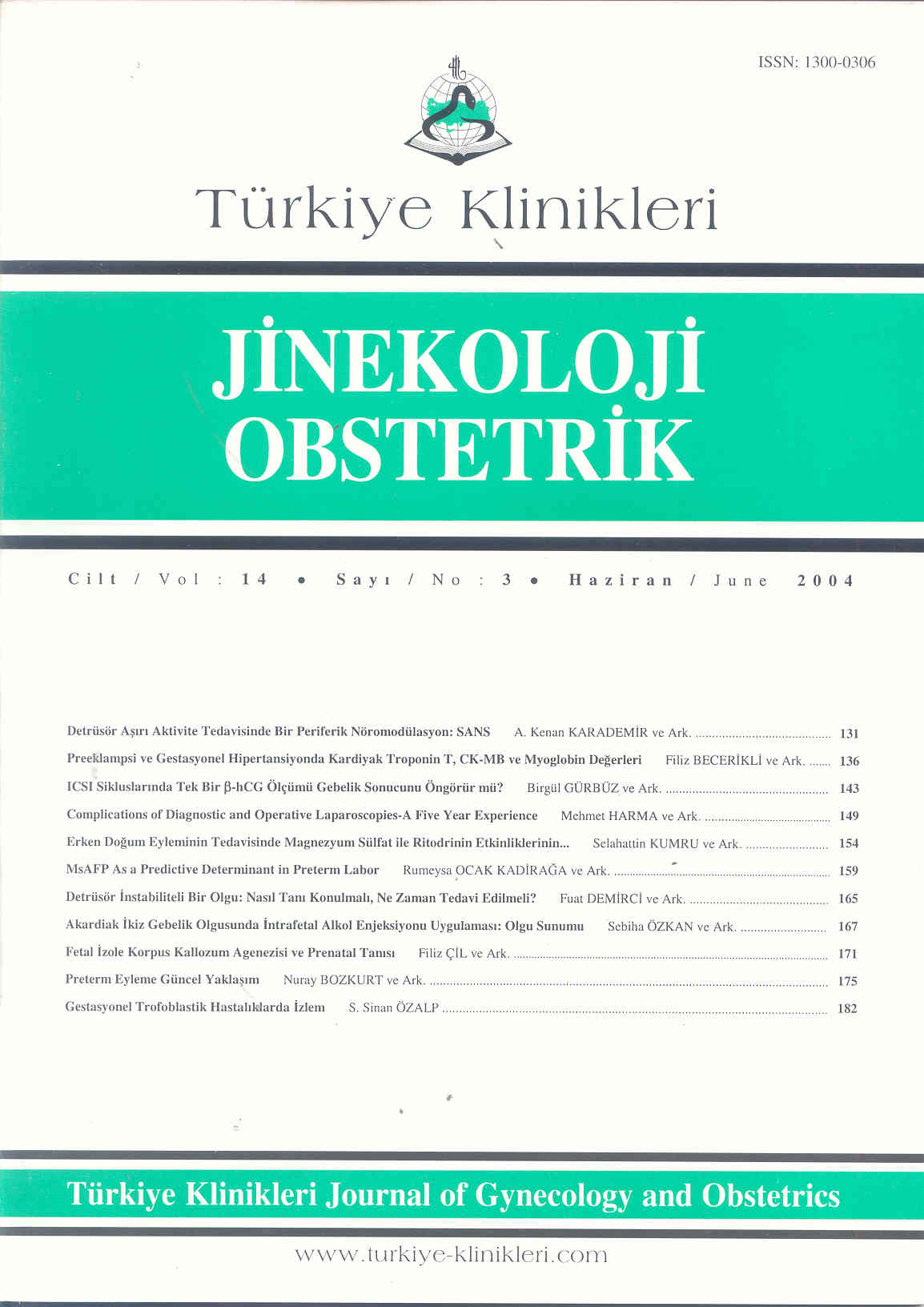Open Access
Peer Reviewed
ORIGINAL RESEARCH
3388 Viewed988 Downloaded
Complications of Diagnostic and Operative Laparoscopies ? A Five Year Experience
Di̇agnosti̇k Ve Operati̇f Laparoskopi̇ Kompli̇kasyonlari ? Beş Yillik Deneyi̇mi̇mi̇z
Turkiye Klinikleri J Gynecol Obst. 2004;14(3):149-53
Article Language: TR
Copyright Ⓒ 2025 by Türkiye Klinikleri. This is an open access article under the CC BY-NC-ND license (http://creativecommons.org/licenses/by-nc-nd/4.0/)
ÖZET
Amaç: Bu çalışmada, Harran Üniversitesi Tıp Fakültesi Kadın Hastalıkları ve Doğum Kliniğinde yapılan tüm diagnostik ve operatif laparoskopik girişimlerdeki komplikasyon sıklığının, retrospektif olarak değerlendirilmesi amaçlandı.Gereç ve Yöntemler: Çalışmada, Aralık 1998 ve Ekim 2003 tarihleri arasında CO2 gazı kullanılarak yapılan 151 (84 diagnostik, 26 operatif ve bipolar koagulasyon yapılan 41 tubal sterilizasyon) laparoskopi incelendi. Olguların kayıtları ve ameliyat raporlarındaki komplikasyonlar belirlendi.Bulgular: Laparoskopi yapılan olguların 3 (%1.9)ünde laparotomiye geçildi. Komplikasyon olarak en sık (55 olgu; %36.4) postoperatif ağrı saptandı. Diğer komplikasyonlar, trokara bağlı zedelenme (4 olgu; %2.6), manipulatöre bağlı uterus perforasyonu (4 olgu; %2.6), anestezik komplikasyonlar (3 olgu; %1.9), cilt altı amfizemi (2 olgu; %1.3), postoperatif ateş (2 olgu; %1.3), ileus (1 olgu; %0.6) idi. Bir (%0.6) olgu septik şok sonrası gelişen koma sonucunda ex oldu.Sonuç: Laparoskopi etkin ve görece güvenilir bir işlemdir. Ancak, düşük oranda da olsa, mortalite gibi daha ciddi komplikasyonların gelişebileceği dikkate alınmalıdır. Operatif laparoskopinin giderek yaygınlaşmasıyla komp-likasyon oranının artması beklenmektedir. Komplikasyonların prevalansını azaltmak için eğitim programları sürdürülmeli ve laparoskopik cerrahinin olası riskleri bilinmelidir.
Amaç: Bu çalışmada, Harran Üniversitesi Tıp Fakültesi Kadın Hastalıkları ve Doğum Kliniğinde yapılan tüm diagnostik ve operatif laparoskopik girişimlerdeki komplikasyon sıklığının, retrospektif olarak değerlendirilmesi amaçlandı.Gereç ve Yöntemler: Çalışmada, Aralık 1998 ve Ekim 2003 tarihleri arasında CO2 gazı kullanılarak yapılan 151 (84 diagnostik, 26 operatif ve bipolar koagulasyon yapılan 41 tubal sterilizasyon) laparoskopi incelendi. Olguların kayıtları ve ameliyat raporlarındaki komplikasyonlar belirlendi.Bulgular: Laparoskopi yapılan olguların 3 (%1.9)ünde laparotomiye geçildi. Komplikasyon olarak en sık (55 olgu; %36.4) postoperatif ağrı saptandı. Diğer komplikasyonlar, trokara bağlı zedelenme (4 olgu; %2.6), manipulatöre bağlı uterus perforasyonu (4 olgu; %2.6), anestezik komplikasyonlar (3 olgu; %1.9), cilt altı amfizemi (2 olgu; %1.3), postoperatif ateş (2 olgu; %1.3), ileus (1 olgu; %0.6) idi. Bir (%0.6) olgu septik şok sonrası gelişen koma sonucunda ex oldu.Sonuç: Laparoskopi etkin ve görece güvenilir bir işlemdir. Ancak, düşük oranda da olsa, mortalite gibi daha ciddi komplikasyonların gelişebileceği dikkate alınmalıdır. Operatif laparoskopinin giderek yaygınlaşmasıyla komp-likasyon oranının artması beklenmektedir. Komplikasyonların prevalansını azaltmak için eğitim programları sürdürülmeli ve laparoskopik cerrahinin olası riskleri bilinmelidir.
ABSTRACT
Objective: This retrospective study was carried out to determine the success rate and the incidence of complications of all diagnostic and operative laparoscopies which were performed in the Harran University Obstetrics and Gynecology Department.Material and Methods: During the period December 1998 to October 2003, 151 laparoscopies (84 diagnostic, 26 operative, and 41 tubal sterilization with bipolar coagulation) were reviewed, all with CO2 insufflation. The charts and surgical reports of cases were abstracted and complications recorded.Results: Only three (1.9%) required conversion to laparotomy. The most frequent complication was postoperative pain (55 cases; 36.4% of total cases). Four patients (2.6% of total) suffered trochar-related injuries, four (2.6%) uterine perforation with the uterine manipulator, three (1.9%) anesthetic complications, two (1.3%) subcutaneous emphysema, two (1.3%) postoperative fever and one (0.6%) postoperative adynamic ileus. There was one (0.6%) possibly associated death.Conclusion: Laparoscopy has proved an effective and relatively safe procedure. However, more serious complications ?i.e. mortality? should be considered even in a low rate. As operative laparoscopy becomes more widely accepted the complication rate can be expected to rise. In order to reduce the prevalence of complications, training programmes must include supervision at all levels of development and there must be a high degree of awareness of the potential risks of laparoscopic surgery.
Objective: This retrospective study was carried out to determine the success rate and the incidence of complications of all diagnostic and operative laparoscopies which were performed in the Harran University Obstetrics and Gynecology Department.Material and Methods: During the period December 1998 to October 2003, 151 laparoscopies (84 diagnostic, 26 operative, and 41 tubal sterilization with bipolar coagulation) were reviewed, all with CO2 insufflation. The charts and surgical reports of cases were abstracted and complications recorded.Results: Only three (1.9%) required conversion to laparotomy. The most frequent complication was postoperative pain (55 cases; 36.4% of total cases). Four patients (2.6% of total) suffered trochar-related injuries, four (2.6%) uterine perforation with the uterine manipulator, three (1.9%) anesthetic complications, two (1.3%) subcutaneous emphysema, two (1.3%) postoperative fever and one (0.6%) postoperative adynamic ileus. There was one (0.6%) possibly associated death.Conclusion: Laparoscopy has proved an effective and relatively safe procedure. However, more serious complications ?i.e. mortality? should be considered even in a low rate. As operative laparoscopy becomes more widely accepted the complication rate can be expected to rise. In order to reduce the prevalence of complications, training programmes must include supervision at all levels of development and there must be a high degree of awareness of the potential risks of laparoscopic surgery.
MENU
POPULAR ARTICLES
MOST DOWNLOADED ARTICLES





This journal is licensed under a Creative Commons Attribution-NonCommercial-NoDerivatives 4.0 International License.










